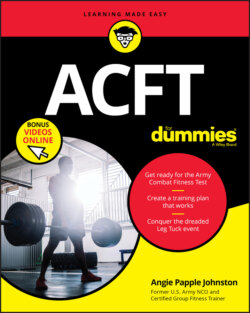Читать книгу ACFT For Dummies - Angela Papple Johnston - Страница 38
The Preparation Drill
ОглавлениеA soldier who isn’t taking the ACFT leads the Preparation Drill — the Army’s dynamic warm-up. The Preparation Drill leader reads these instructions aloud:
You are about to take the Army Combat Fitness Test, or ACFT, a test that will measure your upper and lower body muscular endurance, muscular strength, aerobic endurance, anaerobic endurance, and explosive power. The results of this test will give you and your commanders an indication of your state of physical readiness and will act as a guide in determining your physical training needs. After selecting a lane with your preferred weight for the 3 Repetition Maximum Deadlift Event, you may be assigned to a different lane for the next events. You will rest and recover while other soldiers complete their turns. After the last soldier completes the Leg Tuck event, there will be a 10-minute recovery period for all tested soldiers before the start of the 2-Mile Run. Do the best you can on each of the events.
The Preparation Drill lasts 10 minutes, and during that time, you’re encouraged to perform the whole drill while in formation. You can skip exercises if you believe they may exhaust you or hurt your ability to perform well on the test. These are the Preparation Drill exercises, which are part of Holistic Health and Fitness, or H2F (and you thought that whole new PT program wasn’t leading up to anything!):
Bend and Reach
Rear Lunge
High Jumper
Rower
Squat Bender
Windmill
Forward Lunge
Prone Row
Bent Leg Body Twist
Push-up
After the Preparation Drill, you get to figure out which MDL weight is right for you. You can use that time to warm up by lifting the hex bars. If you choose to do so, the Army recommends doing eight to ten reps at about 25 percent of your goal weight and then resting for two minutes, six reps at 40 percent of your goal weight and resting for three minutes, four reps at half your goal weight and resting for four minutes, or one rep at 80 percent of your goal weight and resting until the MDL begins. You know your body, though, and you know what you need to do to get warmed up — don’t overdo it before the test starts because you’re feeling pumped.
By the time you take the ACFT, you should know what MDL weight is right for you. The time to get familiar with what your body can handle is now, before you even show up for a record ACFT. You don’t necessarily have to expend your energy figuring out your weight after the test has begun; if you’ve been practicing, you’ll know how much you can lift on test day.
The test administrators hand out scorecards (if they weren’t handed out before), and the OIC or NCOIC instructs everyone to fill in personal information. See Chapter 4 for a copy of the scorecard and more information on how it works. You must carry your scorecard to the first event and give it to your grader. You get it back after the MDL and hand-carry it to the SPT. From there, your grader keeps the card for the duration of the test.
The OIC or NCOIC then reads this statement:
You will continue to observe the ACFT test area and follow instructions from the OIC or NCOIC throughout the test. During the events, you may conduct your choice of preparation activities. During the test, you may observe all events and offer appropriate verbal motivation to test takers. It is your responsibility to complete proper preparation and know the event standards prior to taking the ACFT. What are your questions about the event standards?
After you determine what MDL weight you’re lifting for the test, you line up behind it with the other soldiers who are lifting the same weight. Graders ensure each MDL lane has an even distribution of soldiers, trying to keep it at five or fewer. Soldiers can assist graders with changing weight plates if necessary. When all the soldiers are lined up, the NCOIC begins the event.
